Originally published on May 9, 2009, this article takes us to the annual all-Michoacán Tianguis Artesanal Domingo de Ramos (Palm Sunday Artisans' Fair) in Uruapan, Michoacán. The 2013 fair opens today (March 23) and runs until April 6.
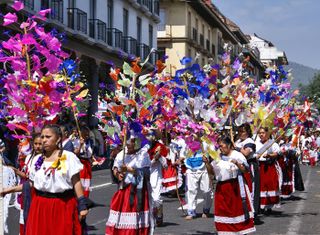
Waving papel picado (cut paper) dance sticks and elegantly
dressed in red velvet aprons trimmed with lace , these Purhépecha women
danced their way through the opening day parade at the annual
statewide Feria de Artesanías.
Mexico Cooks! has attended the Feria de Artesanía de Domingo de Ramos
(Palm Sunday Artisans' Fair) in Uruapan, Michoacán, every year for
nearly 15 years. The two-week-long fair is always the same and yet
never boring, a remarkable combination. This largest artisans' fair in
Mexico draws more than 1200 vendors and contestants for the
best-of-the-best from all over the state of Michoacán. It attracts
international tourism: we've heard languages from all over the globe as
we walk the vendors' aisles.
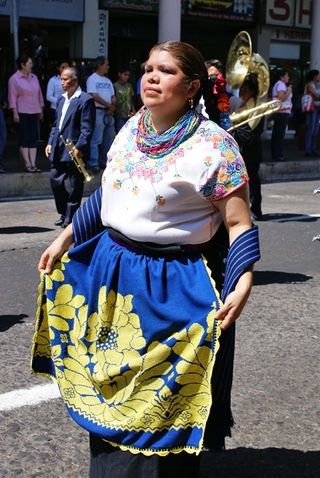
Purhépecha women's festive ropa típica (native dress) includes a knife-pleated skirt, a hand-embroidered guanengo (blouse), a cross-stitch apron, and the long, rectangular blue, black, and white striped rebozo (shawl) that is typical to the region.
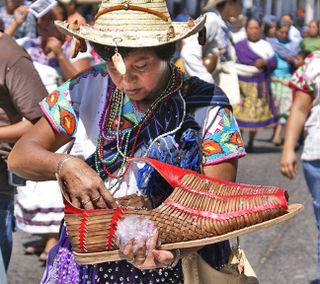
This woman marched while carrying an enormous huarache
(shoe made of woven leather strips) representing the goods that her
region of the state produces. She's also carrying a bag of souvenir key
chains that she tossed to individuals in the crowd. Look closely and
you'll see the tiny huarache key chains that decorate her sombrero de paja (straw hat).
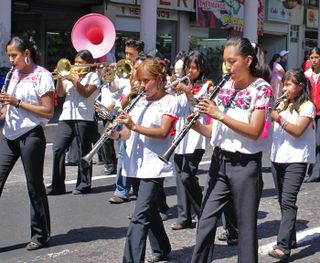
Clarinets, trumpets, trombones, and a pink tuba–what a great band!

Artisans hawk thousands of traditional low-fired clay pots and pitchers. These are from Tzintzuntzan, Michoacán.
Michoacán is famous world-wide for its traditional arts and crafts.
For hundreds of years, artisans in this state have produced highly
decorated articles made from locally found materials: clay, wood,
lacquer, textiles, copper, reedwork, and paper maché, among others.
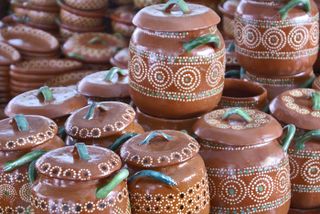
Ollas para frijoles (clay pots for cooking beans) from Capula, Michoacán.
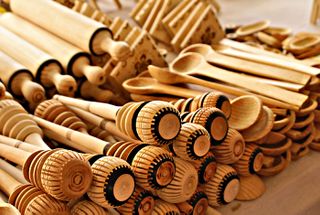
Molinillos (little mills) are used for whipping chocolate caliente (hot chocolate) to a thick froth.
For more about Michoacán-style, hand-made Mexican chocolate, look here: chocolate Joaquinita.
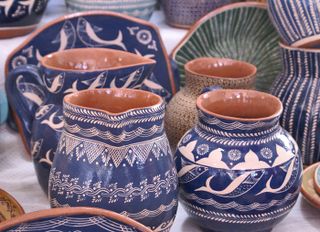
These blue jarras y platones (pitchers and platters) with their finely painted, intricate white designs come from one family workshop in Capula. Mexico Cooks! does not…DOES NOT…have room in the house for more pottery. Well, maybe just one more piece! These glorious jarras were all but impossible to resist.
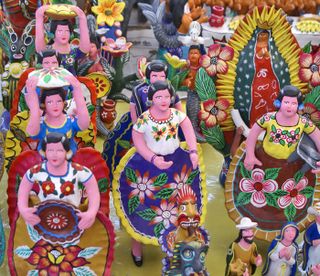
Clay sculptures from Ocumicho, Michoacán, are full of whimsy and bright colors. Among all of these guaris (Purhépecha word for women), did you notice Our Lady of Guadalupe, in the upper right corner?
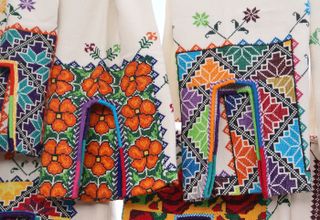
Hand-embroidered traditional cotton guanengos (blouses) are so important and finely made that they have their own concurso (competition) at the Feria de Artesanía (Artisans' Fair).
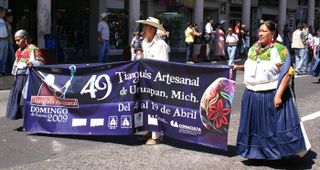
2014 will be the 55th anniversary of the Artisans' Fair in Uruapan. Come see it with us!
Looking for a tailored-to-your-interests specialized tour in Mexico? Click here: Tours.
Leave a Reply